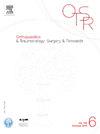Analysis of risk factors for modification of femoral offset after internal fixation of Garden I and II femoral neck fractures
IF 2.2
3区 医学
Q2 ORTHOPEDICS
引用次数: 0
Abstract
Background
The concept of restoring the femoral offset is well established during hip replacement surgery, but is less well known when treating Garden I or II femoral neck fractures by internal fixation. And yet, the therapeutic aim for these fractures is to restore this native parameter as best possible. The aim of this study was to identify the risk factors for reduction of femoral offset after union of a Garden I or II femoral neck fracture treated by internal fixation.
Hypothesis
After internal fixation of a femoral neck fracture, certain factors may contribute to reducing the femoral offset, which itself has been identified as being responsible for altering the patients’ quality of life and functional outcomes.
Materials and methods
This multicenter study included 193 patients who had a Garden I or II femoral neck fracture treated by cannulated screws or a sliding compression screw-plate. The difference between the femoral offset in the operated hip and that of the contralateral hip was measured in weightbearing patients after the fracture had healed. This difference was the primary outcome measure. Univariate and multivariate analyses were done to look for risk factors contributing to femoral neck shortening.
Results
Based on the univariate analysis, being more than 85 years of age, having a Garden I fracture, and cannulated screw fixation were associated with a significantly greater reduction in the femoral offset. In the multivariate analysis, only Garden I fractures were associated with a greater reduction in femoral offset.
Discussion
Garden I fractures were associated with a greater reduction in the offset, although there was no evidence that this change was related to early weightbearing. By identifying this risk factor, surgeons can optimize the indications given that the treatment of these fractures is still widely debated and there is still no consensus as to the best method.
Level of evidence
IV
Garden I 和 II 型股骨颈骨折内固定术后股骨偏移改变的风险因素分析。
背景:在髋关节置换手术中,恢复股骨偏移量的概念已广为人知,但在通过内固定治疗 Garden I 或 II 型股骨颈骨折时,这一概念却鲜为人知。然而,这些骨折的治疗目标是尽可能恢复这一原生参数。本研究旨在确定通过内固定治疗 Garden I 或 II 型股骨颈骨折后股骨偏移量减少的风险因素:假设:股骨颈骨折内固定术后,某些因素可能会导致股骨偏移量的减少,而股骨偏移量本身已被确定为改变患者生活质量和功能结果的原因:这项多中心研究共纳入了193名接受插管螺钉或滑动加压螺钉-钢板治疗的Garden I或II型股骨颈骨折患者。骨折愈合后,在患者负重情况下测量了手术髋关节股骨偏移量与对侧髋关节股骨偏移量之间的差异。这一差异是主要的结果测量指标。对导致股骨颈缩短的风险因素进行了单变量和多变量分析:根据单变量分析,年龄超过85岁、Garden I骨折和插管螺钉固定与股骨偏移量明显减少有关。在多变量分析中,只有Garden I型骨折与股骨偏移量的增加有关:讨论:Garden I型骨折与股骨偏移量的增加有关,但没有证据表明这种变化与早期负重有关。通过识别这一风险因素,外科医生可以优化适应症,因为对这些骨折的治疗仍存在广泛争议,而且对最佳方法仍未达成共识:证据等级:IV。
本文章由计算机程序翻译,如有差异,请以英文原文为准。
求助全文
约1分钟内获得全文
求助全文
来源期刊
CiteScore
5.10
自引率
26.10%
发文量
329
审稿时长
12.5 weeks
期刊介绍:
Orthopaedics & Traumatology: Surgery & Research (OTSR) publishes original scientific work in English related to all domains of orthopaedics. Original articles, Reviews, Technical notes and Concise follow-up of a former OTSR study are published in English in electronic form only and indexed in the main international databases.

 求助内容:
求助内容: 应助结果提醒方式:
应助结果提醒方式:


